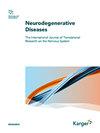CLN6基因突变引起的一个中国血缘家族的幼年发病性库夫斯病
IF 1.9
4区 医学
Q3 CLINICAL NEUROLOGY
引用次数: 1
摘要
目的:探讨同一家族2例库夫斯病的遗传原因。在磁共振成像(MRI)下,两个受影响的个体表现出不同程度的严重程度。方法:对患病个体进行全外显子组测序,Sanger测序确认候选基因。Western blot检测239T细胞中CLN6蛋白的表达水平。结果:我们在两个患有库夫斯病的中国近亲家庭中发现了一种新的CLN6基因纯合突变(c.14G>T, p.Arg5Leu)。两例患者均表现为癫痫发作、进行性精神运动减退和智力退化,无视力损害。他们的发病年龄不同,尽管他们携带了相同的错义突变。患病女性双侧海马MRI异常信号明显,而其弟弟仅表现出非常轻微的异常信号。进一步的研究表明,这种错义突变可以降低CLN6蛋白的表达水平。结论:发现了一种新的CLN6基因纯合突变,具有相同突变的患者在MRI下表现出不同的发病年龄和不同的严重程度。意义:我们的研究确立了同一个CLN6突变在患者中可以产生不同的表型,扩大了CLN6基因的突变和表型谱。本文章由计算机程序翻译,如有差异,请以英文原文为准。
Juvenile-Onset Kufs Disease in a Chinese Consanguineous Family due to CLN6 Mutation
Objective: The aim of this study was to identify the genetic cause of two cases of Kufs disease in the same family. The two affected individuals exhibited different levels of severity under magnetic resonance imaging (MRI). Methods: Whole-exome sequencing was performed on affected individuals, and the candidate gene was confirmed by Sanger sequencing. Western blot analysis was used to evaluate the level of expression of CLN6 protein in 239T cells. Results: We identified a novel homozygous mutation of the CLN6 gene (c.14G>T, p.Arg5Leu) in a consanguineous Chinese family in which two people had Kufs disease. Both patients exhibited seizures and progressive psychomotor decline and mental deterioration without visual impairment. They had different ages of onset, although they carried the same missense mutation. The affected female showed a pronounced abnormal MRI signal in the bilateral hippocampus, while her younger brother only showed a very slight abnormal signal. Further study showed that this missense mutation could decrease the level of expression of CLN6 protein. Conclusions: A novel homozygous mutation of the CLN6 gene was identified, and patients with the same mutation showed different ages of onset and different levels of severity under MRI. Significance: Our study established that the same CLN6 mutation could produce different phenotypes in patients, and it has expanded the mutational and phenotypical spectrum of the CLN6 gene.
求助全文
通过发布文献求助,成功后即可免费获取论文全文。
去求助
来源期刊

Neurodegenerative Diseases
医学-临床神经学
CiteScore
5.90
自引率
0.00%
发文量
14
审稿时长
6-12 weeks
期刊介绍:
''Neurodegenerative Diseases'' is a bimonthly, multidisciplinary journal for the publication of advances in the understanding of neurodegenerative diseases, including Alzheimer''s disease, Parkinson''s disease, amyotrophic lateral sclerosis, Huntington''s disease and related neurological and psychiatric disorders.
 求助内容:
求助内容: 应助结果提醒方式:
应助结果提醒方式:


